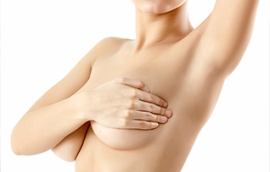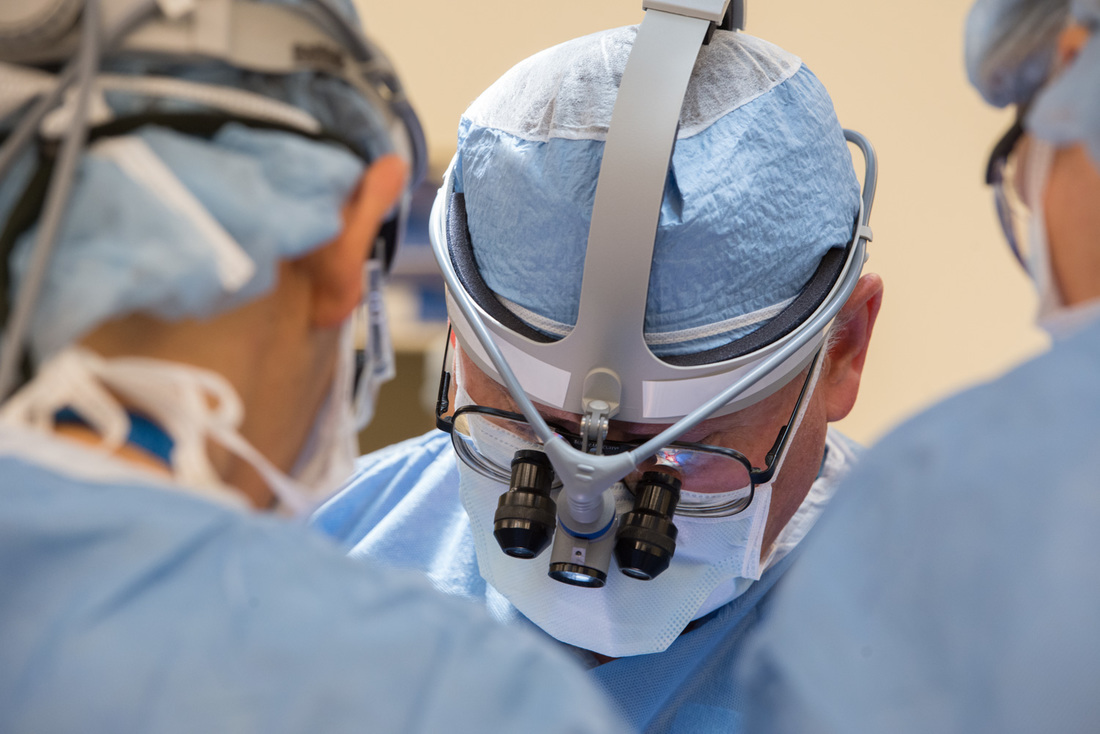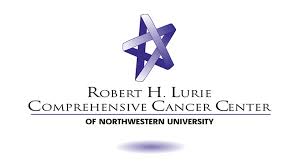|
Nipple-Sparing MastectomyFor those patients with a size A, B or a smaller C cup with a cancer that is not too close to the nipple, a nipple-sparing mastectomy, sometimes referred to as a “no visible scar mastectomy” may be an option. Nipple-sparing mastectomy is also the preferred method for prophylactic mastectomies in those patients at a high risk for breast cancer, such as those who are BRCA positive. In these procedures the incision is made along the bottom of the breast in the infra-mammary crease. Although there is little or no sensation to the preserved nipple and there is a small risk of inadequate blood flow to the nipple it does provide the best cosmetic result by far. Occasionally I will perform a "Delay Procedure" 2-3 weeks prior to the mastectomy in order to reduce the risk of inadequate blood flow.
I have performed over 250 nipple-sparing mastectomies and many times it is nearly impossible for the untrained eye to determine that the patient has had a mastectomy. |
Breast Reconstruction at Northwestern
At Northwestern Medicine, our team of plastic and reconstructive surgeons (see list below) performs all aspects of breast reconstruction and offer the latest cutting edge techniques in breast restoration. Our expertise covers a wide spectrum of surgical procedures that include implant and autologous reconstruction with their various forms. During consultation with one of our plastic surgeons, a comprehensive surgical plan will be designed specifically to meet your needs and achieve your desired goals.
Implant based breast reconstruction
Reconstruction with implants is the most common type of breast reconstruction. This procedure is typically done immediately at the time of mastectomy and takes approximately one hour to perform per breast. There are two types of implant procedures: one that involves the placement of a tissue expander first, followed by exchange to a permanent implant a few months later, and another where a permanent implant is inserted immediately in one stage without expansion. A tissue expander is a balloon placed at the time of the mastectomy under the muscle to stretch the chest muscle and skin to recreate the breast mound. During follow up office appointments, the expander is gradually filled through a valve with saline (salt water) solution until the desired size is reached. The expander is then removed and a permanent implant is placed. All subsequent surgeries are done as outpatient procedures. A single-staged direct to implant reconstruction is also offered in the right setting and in patients who are good candidates for the procedure. Both round and shaped (tear drop or gummy bear) implants, saline and silicone, are available and offered to patients. Fat grafting is often combined with implant breast reconstruction and is harvested from other areas in the body like the abdomen and thighs. Women with a small to medium-sized breast with little or no drooping who do not want additional scars on other parts of their bodies are usually ideal candidates for implant reconstruction. At Northwestern we employ the latest techniques and technologies in implant based breast reconstruction including the newest implants, expanders and support matrices.
Breast reconstruction using tissue from your abdomen
Autologous reconstruction is breast reconstruction using a woman’s own body tissue. It has several advantages including a more natural look and feel and normal ptosis (drooping of the breast). The most common site where tissue is taken from is the abdomen. Abdominal flap reconstruction uses skin, fat, and possibly muscle between the navel and pelvic bone to replace the removed breast. The result is a flatter stomach and a breast mound reconstruction made of the patient’s own tissue. Microsurgery is often used to help in the movement of tissue from the abdomen to the chest if the tissue is disconnected from the body during surgery. These flaps are called “free flaps”. Depending on the anatomy of the blood vessels to the tissue, varying portions of the abdominal muscles may also be harvested. If a portion of the muscle is taken this is called a “muscle-sparing TRAM flap”, If no muscle is taken from the abdomen, this is called a “DIEP” flap or “SIEA” flap. A “DIEP” flap is a perforator flap which is a recent refinement of the conventional flap where none of the underlying muscle is used. Each technique results in a hip to hip scar near the underwear line that will fade over time. Using your own tissue provides long lasting results without the use of implants and is the preferred reconstruction if radiation therapy is to be part of cancer treatment. However, surgery and recovery take longer than implant surgery.
Breast reconstruction using tissue from your back
Latissimus flap reconstruction utilizes skin and muscle from the back, which is tunneled just under the skin to the reconstructed breast. The flap stays connected to its donor site, leaving blood supply intact. Because the back has less fatty tissue than the abdomen, an implant is generally necessary to achieve the desired breast size. This procedure is less involved than a free flap and requires less recovery time.
Breast reconstruction using tissue from other areas
Skin and fat can be transferred from other areas of the body to replace the removed breast. Other free flaps used for breast reconstruction include thigh-based flaps like the TUG flap with its variations and the PAP flap in addition to gluteal or buttock flaps (SGAP). A sufficient amount of tissue has to be available for transfer in order for the patient to be a good candidate. Breast reconstruction using fat transfer alone with or without the use of the BRAVA external tissue expansion system are also available under the right circumstances.
Oncoplastic surgery and breast conservation
This procedure combines a lumpectomy or partial mastectomy with a breast lift or breast reduction to preserve the breast. A matching breast lift or reduction is performed on the other non cancer side. A lumpectomy procedure preserves the breast but requires postoperative radiation. Women with large breasts who are considered good candidates for breast reduction are generally good candidates for oncoplastic reduction. If the breast size is small, breast conservation can still be performed in some patients by filling the resulting lumpectomy cavity with tissue brought from the back (skin or muscle or a combination). The main advantage of breast conservation is that it preserves breast sensation.
Nipple and Areola reconstruction
If a skin-sparing mastectomy is performed a raised nipple can be reconstructed with the skin and the areola is than tattooed to match the opposite breast. A new nipple can also be created using a 3-D tattoo technique. No matter which method is used there is no sensation within the nipple.
Implant based breast reconstruction
Reconstruction with implants is the most common type of breast reconstruction. This procedure is typically done immediately at the time of mastectomy and takes approximately one hour to perform per breast. There are two types of implant procedures: one that involves the placement of a tissue expander first, followed by exchange to a permanent implant a few months later, and another where a permanent implant is inserted immediately in one stage without expansion. A tissue expander is a balloon placed at the time of the mastectomy under the muscle to stretch the chest muscle and skin to recreate the breast mound. During follow up office appointments, the expander is gradually filled through a valve with saline (salt water) solution until the desired size is reached. The expander is then removed and a permanent implant is placed. All subsequent surgeries are done as outpatient procedures. A single-staged direct to implant reconstruction is also offered in the right setting and in patients who are good candidates for the procedure. Both round and shaped (tear drop or gummy bear) implants, saline and silicone, are available and offered to patients. Fat grafting is often combined with implant breast reconstruction and is harvested from other areas in the body like the abdomen and thighs. Women with a small to medium-sized breast with little or no drooping who do not want additional scars on other parts of their bodies are usually ideal candidates for implant reconstruction. At Northwestern we employ the latest techniques and technologies in implant based breast reconstruction including the newest implants, expanders and support matrices.
Breast reconstruction using tissue from your abdomen
Autologous reconstruction is breast reconstruction using a woman’s own body tissue. It has several advantages including a more natural look and feel and normal ptosis (drooping of the breast). The most common site where tissue is taken from is the abdomen. Abdominal flap reconstruction uses skin, fat, and possibly muscle between the navel and pelvic bone to replace the removed breast. The result is a flatter stomach and a breast mound reconstruction made of the patient’s own tissue. Microsurgery is often used to help in the movement of tissue from the abdomen to the chest if the tissue is disconnected from the body during surgery. These flaps are called “free flaps”. Depending on the anatomy of the blood vessels to the tissue, varying portions of the abdominal muscles may also be harvested. If a portion of the muscle is taken this is called a “muscle-sparing TRAM flap”, If no muscle is taken from the abdomen, this is called a “DIEP” flap or “SIEA” flap. A “DIEP” flap is a perforator flap which is a recent refinement of the conventional flap where none of the underlying muscle is used. Each technique results in a hip to hip scar near the underwear line that will fade over time. Using your own tissue provides long lasting results without the use of implants and is the preferred reconstruction if radiation therapy is to be part of cancer treatment. However, surgery and recovery take longer than implant surgery.
Breast reconstruction using tissue from your back
Latissimus flap reconstruction utilizes skin and muscle from the back, which is tunneled just under the skin to the reconstructed breast. The flap stays connected to its donor site, leaving blood supply intact. Because the back has less fatty tissue than the abdomen, an implant is generally necessary to achieve the desired breast size. This procedure is less involved than a free flap and requires less recovery time.
Breast reconstruction using tissue from other areas
Skin and fat can be transferred from other areas of the body to replace the removed breast. Other free flaps used for breast reconstruction include thigh-based flaps like the TUG flap with its variations and the PAP flap in addition to gluteal or buttock flaps (SGAP). A sufficient amount of tissue has to be available for transfer in order for the patient to be a good candidate. Breast reconstruction using fat transfer alone with or without the use of the BRAVA external tissue expansion system are also available under the right circumstances.
Oncoplastic surgery and breast conservation
This procedure combines a lumpectomy or partial mastectomy with a breast lift or breast reduction to preserve the breast. A matching breast lift or reduction is performed on the other non cancer side. A lumpectomy procedure preserves the breast but requires postoperative radiation. Women with large breasts who are considered good candidates for breast reduction are generally good candidates for oncoplastic reduction. If the breast size is small, breast conservation can still be performed in some patients by filling the resulting lumpectomy cavity with tissue brought from the back (skin or muscle or a combination). The main advantage of breast conservation is that it preserves breast sensation.
Nipple and Areola reconstruction
If a skin-sparing mastectomy is performed a raised nipple can be reconstructed with the skin and the areola is than tattooed to match the opposite breast. A new nipple can also be created using a 3-D tattoo technique. No matter which method is used there is no sensation within the nipple.
|
For comprehensive information, videos,
photos and testimonials please refer to these 3 linked references: |




